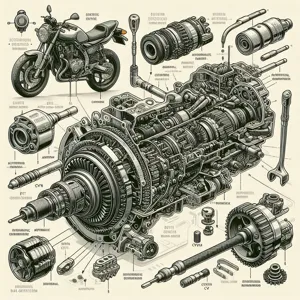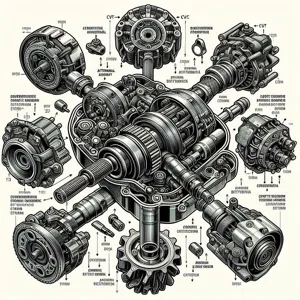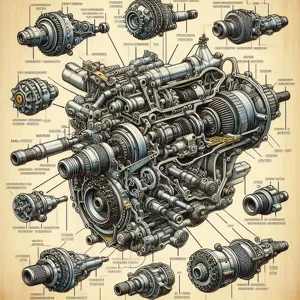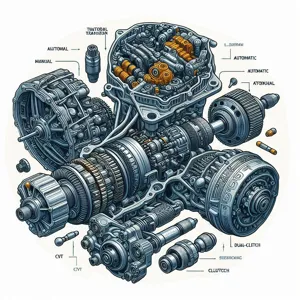For motorcycle enthusiasts and aspiring riders alike, understanding the inner workings of a motorbike is essential for making informed choices on the road and in the garage.
At the heart of any motorcycle’s performance lies the transmission, a complex system that plays a crucial role in how power is delivered from the engine to the wheels. With various types of transmissions available, each offering unique advantages and driving experiences, it can be challenging to navigate the nuances of this vital component. In this blog post, we will explore the different types of motorbike transmissions—ranging from the classic manual to the innovative automatic and everything in between. We’ll break down their key differences, advantages, and the impact they have on your riding experience, helping you to better grasp this essential aspect of motorbike mechanics. Whether you’re a seasoned rider looking to upgrade or a beginner eager to learn, this comprehensive guide will equip you with the knowledge to make the best choice for your riding style and preferences.
1. Introduction to Motorbike Transmissions

Motorbike transmissions play a pivotal role in defining the performance, handling, and overall riding experience of a motorcycle. Much like the engine, the transmission is the heart of the machine, translating the power generated by the engine into the motion that propels the bike forward. Understanding the different types of motorbike transmissions and their key differences can be the key to choosing the right bike for your riding style and preferences.
At its core, a motorcycle transmission is responsible for shifting gears, allowing the rider to adjust the power and speed of the bike according to the terrain and riding conditions. Unlike cars, where automatic transmissions have become the norm, motorcycles offer a variety of transmission types ranging from the traditional manual setup to more modern automatic systems. Each type comes with its own set of advantages and intricacies, influencing how riders interact with their machines.
In this section, we will explore the fundamental concepts behind motorbike transmissions, shedding light on their importance in the overall functionality of a motorcycle. We will delve into the mechanics of how these systems work, their different configurations, and the benefits they offer. Whether you’re a seasoned rider or a newcomer to the world of motorbikes, gaining a deeper understanding of transmissions will enhance your appreciation of the engineering marvels that are motorcycles, and empower you to make informed decisions when it comes to selecting the right bike for your journey ahead.
2. The Importance of Transmission in Motorbike Performance
The transmission system of a motorbike is often likened to the heart of its performance, intricately connecting the engine’s powerful output to the wheels that turn and propel the bike forward. Understanding the importance of transmission in motorbike performance is crucial for both aspiring riders and seasoned enthusiasts alike.
At its core, the transmission is responsible for controlling the bike’s speed and torque, allowing the rider to harness the engine’s power efficiently. A well-tuned transmission ensures smooth gear shifts, enabling a seamless transition between acceleration and deceleration. This is especially important when navigating tight corners or accelerating out of a turn, where the rider’s ability to control power delivery can significantly affect handling and stability.
Different transmission types—such as manual, automatic, and semi-automatic—offer unique riding experiences and performance characteristics. Manual transmissions, often favored by purists, require the rider to engage the clutch and select gears manually, providing a heightened sense of control and direct engagement with the bike’s mechanics. In contrast, automatic and semi-automatic transmissions offer convenience and ease of use, allowing riders to focus more on the road ahead while the bike does the heavy lifting of gear changes.
Moreover, the transmission’s design can influence fuel efficiency and overall bike performance. A well-calibrated transmission can lead to optimal engine performance, enhancing acceleration, improving fuel economy, and reducing wear and tear on components.
In summary, the transmission is not merely a mechanical component; it is a pivotal aspect that shapes the riding experience. By understanding its role and the different types available, riders can make informed decisions that not only enhance their performance but also elevate their enjoyment on the road. Whether you’re a weekend warrior or a daily commuter, the right transmission can transform your ride, making it smoother, more responsive, and ultimately more exhilarating.
3. Overview of Manual Transmissions

Manual transmissions, often revered by motorcycle enthusiasts for the level of control they offer, are a staple in the world of motorbike engineering. Unlike their automatic counterparts, manual transmissions require the rider to engage gears manually, delivering a hands-on experience that many find exhilarating. At the heart of a manual transmission is a system of gears and a clutch that work in tandem to optimize power delivery from the engine to the wheels.
When you twist the throttle on a motorcycle with a manual transmission, it’s your skill and timing that dictate how smoothly power flows. Riders must coordinate their throttle input with clutch engagement and gear shifting—a dance that can take time to master but rewards with a deep sense of connection to the machine. This transmission type typically features a sequential shifting pattern, meaning that the rider shifts through the gears in a specific order, often via foot levers or hand controls.
One significant advantage of manual transmissions is their versatility. Riders can choose the appropriate gear based on riding conditions, allowing for more efficient fuel consumption and better handling in diverse terrains. For example, lower gears provide more torque for climbing hills or navigating tight corners, while higher gears are ideal for cruising at speed on the open road.
However, manual transmissions do require more attention and effort from the rider. This can be a drawback for beginners or those who prefer a more relaxed riding experience. Shifting gears incorrectly can lead to stalling or damaging the engine, making it essential for new riders to practice and develop their skills.
In summary, a manual transmission offers a dynamic and engaging riding experience, allowing for precise control and adaptability. While it demands more from the rider, the rewards of mastering this transmission type can lead to a deeper appreciation for the art of motorcycling, enhancing both the journey and the joy of the ride.
4. Exploring Automatic Transmissions
When it comes to motorbike transmissions, automatic systems stand out for their ease of use and accessibility, particularly for new riders. Automatic transmissions eliminate the need for manual gear shifting, allowing the rider to focus solely on the joy of riding. This is achieved through sophisticated engineering that automatically adjusts gear ratios based on speed and throttle input, enabling a seamless transition between gears without any rider intervention.
One of the most common types of automatic transmission found in motorcycles is the continuously variable transmission (CVT). Unlike traditional automatic systems that operate with fixed gears, a CVT uses a system of pulleys and belts to provide a virtually infinite range of gear ratios. This means that the engine can operate at its most efficient RPMs, providing smooth acceleration and optimal power delivery, making it an excellent choice for urban commuting and leisurely rides.
Another option in the world of automatic transmissions is the dual-clutch transmission (DCT), which offers the best of both worlds. DCT systems utilize two separate clutches—one for odd-numbered gears and one for even-numbered gears—allowing for lightning-fast gear changes without the loss of power that often accompanies traditional shifting. This technology provides a sporty feel and responsive performance, appealing to riders seeking a more dynamic riding experience.
Riders opting for automatic transmissions often appreciate the reduced physical demands of riding, allowing for longer journeys without the fatigue associated with constant gear shifting. Additionally, automatic systems can enhance safety by enabling riders to maintain better control of the motorcycle in challenging conditions, such as heavy traffic or adverse weather.
However, the choice between automatic and manual transmissions ultimately depends on personal preference and riding style. While automatic transmissions offer convenience and ease, many experienced riders enjoy the engagement and control that comes with manual shifting. Understanding these differences is crucial for riders looking to choose the transmission that aligns best with their riding ambitions and lifestyle. Whether you choose the simplicity of a CVT or the performance of a DCT, automatic transmissions are revolutionizing the way we experience motorcycling.
5. Semi-Automatic Transmissions: A Hybrid Approach

Semi-automatic transmissions represent a fascinating midpoint in the motorbike transmission landscape, merging the best attributes of both manual and automatic systems. Often found in high-performance motorcycles and some scooters, these transmissions provide riders with a unique blend of control and convenience.
At the heart of a semi-automatic transmission is a mechanism that allows for seamless gear shifting without the need for a traditional clutch lever. Riders can shift gears using a foot lever or handlebar controls, which engages electronic or hydraulic systems to handle the clutch operation automatically. This means that while the rider maintains the exhilaration of choosing their gear, the complexity and physical demands of clutch management are significantly minimized.
One of the key advantages of a semi-automatic transmission is its adaptability. New riders can appreciate the ease of use, as they don’t need to master the intricacies of clutch control, making it a less daunting entry point into the world of motorcycling. More experienced riders, on the other hand, benefit from the added level of control, allowing for quicker shifts in demanding situations, such as during aggressive cornering or acceleration.
Additionally, many semi-automatic systems come equipped with features like engine braking and rev-matching capabilities, enhancing performance and stability. This hybrid approach not only improves riding comfort but also boosts confidence, letting riders focus on the road ahead rather than the mechanics of their bike.
In summary, semi-automatic transmissions are a testament to modern engineering, offering a versatile riding experience that caters to a wide range of skill levels. Whether you’re navigating through city traffic or hitting the open road, a semi-automatic bike can deliver a dynamic ride tailored to your preferences.
6. Continuously Variable Transmission (CVT) Explained
Continuously Variable Transmission (CVT) is a unique and innovative transmission system that has gained popularity in the world of motorbikes for its smooth and seamless power delivery. Unlike traditional transmissions that rely on fixed gear ratios, a CVT operates on a system of pulleys and a belt, allowing for an infinite range of gear ratios. This adaptability means that the engine can always operate at its optimal power range, providing a more responsive and efficient riding experience.
One of the most notable features of a CVT is its ability to eliminate the “shift shock” that can occur during gear changes in conventional automatic or manual transmissions. Riders often describe this as a smoother and more fluid acceleration, allowing them to focus on the road ahead rather than the mechanics of shifting gears. This can be particularly beneficial in urban environments where frequent stops and starts are common, making the ride feel less strenuous and more enjoyable.
In terms of design, a CVT typically features two conical pulleys connected by a belt. As the bike accelerates, the pulleys adjust their distance apart to change the effective diameter of the pulleys, which in turn alters the gear ratio without any noticeable shift points. This dynamic adjustment allows the rider to feel a continuous surge of power, whether they’re cruising along the highway or navigating through city traffic.
However, while CVTs offer numerous advantages such as efficiency and ease of use, they do have some limitations. For instance, they may not provide the same level of engine braking that traditional transmissions offer, which can be a consideration for riders who prefer more control during deceleration. Additionally, the design of a CVT can sometimes lead to increased wear over time, particularly if the system is not properly maintained.
In summary, a Continuously Variable Transmission presents a compelling option for motorbike enthusiasts seeking a smooth, efficient ride without the hassle of manual gear shifting. Understanding the mechanics and benefits of CVTs can help riders make informed decisions about their next bike purchase, ensuring they choose a transmission type that aligns with their riding style and preferences. Whether you’re a daily commuter or an adventurous weekend rider, the CVT could enhance your overall motorcycling experience.
7. Differences Between Manual and Automatic Transmissions

When it comes to motorbike transmissions, the choice between manual and automatic can significantly impact your riding experience. Understanding the key differences between these two transmission types is essential for both novice riders and seasoned enthusiasts looking to make informed decisions.
**Manual Transmissions** are the traditional choice for many motorbike aficionados. With a manual transmission, the rider has complete control over gear selection, allowing for a more engaging and immersive riding experience. This type of transmission typically features a clutch lever and a foot-operated gear shifter. Riders must learn to coordinate the clutch and throttle to smoothly change gears, which can initially seem daunting but ultimately offers a deeper connection to the motorcycle. Manual bikes tend to be lighter and more fuel-efficient, providing a sense of agility that can be particularly appealing when navigating winding roads or tackling off-road terrains. Additionally, many experienced riders appreciate the ability to tailor their gear shifts to match their riding style or the demands of the road.
On the other hand, **Automatic Transmissions** are designed for ease and convenience, making them an attractive option for those new to motorcycling or those who prefer a more relaxed ride. With an automatic transmission, riders do not have to engage a clutch or manually shift gears; the bike does it all for them. This allows for a more straightforward riding experience, particularly in stop-and-go traffic or urban environments where frequent gear changes can be cumbersome. Modern automatic bikes often come equipped with advanced technologies, such as dual-clutch systems, which provide seamless shifting and improved acceleration without sacrificing performance. For many riders, the appeal of an automatic transmission lies in its simplicity and the ability to focus more on enjoying the ride rather than mastering gear changes.
In summary, the choice between manual and automatic transmissions ultimately boils down to personal preference and riding style. Manual transmissions offer a dynamic, engaging experience that many enthusiasts cherish, while automatic transmissions provide convenience and ease, appealing to those looking for a more accessible ride. By understanding these key differences, riders can make informed choices that align with their preferences and enhance their overall motorcycling experience.
8. How Gear Ratios Affect Performance
Gear ratios play a crucial role in determining the performance and handling characteristics of a motorbike, influencing everything from acceleration to top speed. At its core, a gear ratio is the relationship between the number of teeth on two gears that are meshed together. In motorbikes, this typically refers to the ratio between the engine’s crankshaft and the rear wheel. Understanding how these ratios affect performance can help riders make informed choices about their bikes and riding styles.
When you have a lower gear ratio, the engine can turn more revolutions than the rear wheel, resulting in quicker acceleration. This is particularly beneficial for scenarios requiring rapid starts, such as navigating city traffic or taking off from a stoplight. In contrast, a higher gear ratio means the rear wheel turns more times per revolution of the engine, translating to higher speeds with less engine effort. This configuration is ideal for highway cruising, where maintaining speed with reduced engine strain is paramount.
However, it’s essential to consider the trade-offs. While lower gear ratios enhance acceleration, they can also lead to higher engine RPMs at cruising speeds, which may decrease fuel efficiency and increase engine wear. On the other hand, higher gear ratios can improve fuel economy and provide a smoother ride but may result in sluggish acceleration, particularly when navigating steep hills or when a quick burst of speed is needed.
Additionally, the choice of gear ratios can significantly influence the riding experience. A bike equipped with a well-matched gear ratio will feel more responsive and connected to the road, allowing for sharp cornering and confident overtaking. Conversely, poorly matched ratios can lead to a lack of power when you need it most, creating frustration for the rider.
In essence, understanding gear ratios is key to optimizing a motorbike’s performance. Riders should consider their typical riding conditions and styles—whether they favor city commuting, off-road adventures, or long-distance touring—to select a bike with the gear ratios that best suit their needs. Ultimately, the right balance can transform a good ride into an exceptional one, enhancing both excitement and control on the open road.
9. The Role of Clutch Systems in Motorbike Transmissions
The clutch system is a crucial component of motorbike transmissions, serving as the bridge between the engine and the transmission itself. Its primary function is to engage and disengage the engine’s power from the wheels, allowing riders to smoothly shift gears and control their speed. Understanding the role of clutch systems can significantly enhance your riding experience and maintenance knowledge.
There are two main types of clutch systems commonly found in motorbikes: the traditional manual clutch and the more modern automatic clutch. The manual clutch requires the rider to pull a lever, usually located on the left handlebar, to disengage the engine from the transmission. This action allows for seamless gear changes, but it requires skill and coordination, especially in high-stress situations like racing or navigating through traffic.
On the other hand, automatic clutches simplify the riding experience by eliminating the need for manual engagement. These systems use centrifugal force or hydraulic pressure to engage the clutch at specific RPMs, allowing the bike to shift gears without any input from the rider. This can be particularly beneficial for beginners or those who prefer a more relaxed riding style.
In addition to the type of clutch, the design and materials used can also affect performance. Most clutches consist of friction plates and springs, and the quality of these components can influence the responsiveness and durability of the system. For instance, high-performance bikes often utilize slipper clutches, which enable smoother downshifts and prevent rear-wheel chatter during aggressive braking.
Understanding the clutch system not only enhances your riding proficiency but also aids in proper maintenance. Regular checks for wear and tear, along with timely adjustments, can prolong the life of your clutch and enhance overall transmission performance. Whether you’re a seasoned rider or just starting out, grasping the intricacies of clutch systems is essential for a safe and enjoyable ride.
10. Understanding Chain vs. Shaft Drive Systems
When it comes to motorbike transmissions, one of the most significant choices manufacturers make is between chain and shaft drive systems. Each type offers distinct advantages and drawbacks that can greatly impact your riding experience, maintenance needs, and overall bike performance.
**Chain Drive Systems** are the traditional choice for many motorcycle enthusiasts. They utilize a series of metal links that connect the engine’s output shaft to the rear wheel, offering a direct and efficient transfer of power. One of the key advantages of chain drives is their lightweight construction, which enhances acceleration and agility. Additionally, they are typically less expensive to manufacture and repair, making chain-driven bikes more affordable for many riders.
However, chain drives do require more maintenance. Regular cleaning and lubrication are essential to ensure smooth operation and longevity, as dirt and debris can lead to wear and tear. Riders may also experience chain stretch over time, necessitating adjustments or replacements. Despite these maintenance demands, many riders appreciate the visceral feel of a chain drive, as it often allows for a more engaging and responsive connection to the bike.
On the other hand, **Shaft Drive Systems** provide a more modern and robust alternative. In this configuration, power from the engine is transmitted through a series of gears and a drive shaft to the rear wheel. One of the most significant advantages of shaft drives is their low maintenance requirements. With fewer exposed moving parts, these systems are generally more resilient to the elements, requiring little more than occasional fluid changes to keep them operating smoothly. This makes shaft-driven bikes particularly appealing for long-distance touring and commuting, where reliability is paramount.
However, the benefits of a shaft drive come at a cost. These systems tend to be heavier and can introduce a slight delay in power delivery due to the additional gearing, which some riders may find less engaging. Furthermore, the initial cost of shaft-driven motorcycles is typically higher, which might deter some budget-conscious buyers.
Understanding the differences between chain and shaft drive systems can help you make an informed decision about which type of motorcycle suits your riding style and needs. Whether you prioritize performance and agility or prefer low maintenance and durability, each option has its unique charm that caters to different rider preferences. As you explore the world of motorbike transmissions, consider your personal riding habits and the type of experience you wish to have on the road.
11. Common Issues with Motorbike Transmissions
Motorbike transmissions play a crucial role in the overall performance and longevity of your ride, but they can also be a source of frustration when things go awry. Understanding the common issues that can arise helps you address them promptly and ensure a smooth ride.
One prevalent problem is **slipping gears**, where the transmission unexpectedly shifts out of gear. This can often be attributed to worn clutch plates or low transmission fluid, leading to a jerky ride and potential safety hazards. If you notice your bike revving higher than usual without a corresponding increase in speed, it’s time to investigate further.
Another common issue is **difficulty shifting**, which can manifest as a stiff or unresponsive gear lever. This might be due to improper clutch adjustment, a faulty cable, or even internal transmission wear. Regular maintenance checks can help catch these problems early, saving you from more extensive repairs down the line.
**Unusual noises** during shifting are also a warning sign. Grinding, clunking, or whining sounds can indicate that internal components are misaligned or damaged. Ignoring these sounds can lead to catastrophic failure, so it’s wise to get your bike checked as soon as you notice anything out of the ordinary.
Finally, be aware of **oil leaks**, which are not only messy but can also signal serious transmission issues. Fluid leaks can diminish the lubrication essential for smooth operation, leading to increased wear and tear. Regularly inspecting your bike for leaks and maintaining proper fluid levels is essential for a healthy transmission.
By familiarizing yourself with these common transmission problems, you can take proactive steps to keep your motorbike running smoothly and safely, allowing you to enjoy the open road with confidence.
12. Maintenance Tips for Optimal Transmission Performance
Maintaining your motorbike’s transmission is crucial for ensuring optimal performance and longevity. Just as a well-tuned engine runs smoothly, a well-maintained transmission preserves the bike’s power delivery and enhances your riding experience. Here are some essential maintenance tips to keep your transmission in peak condition.
**1. Regular Fluid Checks and Changes:**
Transmission fluid is vital for lubrication and cooling. Over time, it can become contaminated or break down, leading to increased friction and wear. Check your fluid levels regularly and adhere to the manufacturer’s recommendations for fluid changes. A clean, fresh fluid not only lubricates better but also helps prevent internal damage.
**2. Inspect the Clutch System:**
For bikes with manual transmissions, the clutch system plays a crucial role in shifting gears smoothly. Regularly inspect the clutch lever and cable for wear or fraying. If you notice any stiffness or slipping during gear changes, it may be time to adjust or replace the clutch components to ensure optimal engagement.
**3. Clean and Adjust the Chain:**
For bikes that use a chain drive, keeping the chain clean and properly adjusted is key to smooth transmission performance. A dirty or poorly adjusted chain can lead to excessive wear on both the chain and sprockets, affecting gear shifts. Clean the chain regularly, lubricate it, and ensure it’s at the correct tension to avoid unnecessary strain on the transmission.
**4. Monitor Gear Shifting:**
Pay attention to how your bike shifts gears. If you experience any grinding or difficulty while shifting, it could indicate an underlying issue with the transmission. Addressing these concerns early can help prevent more significant problems down the line. If necessary, consult a professional mechanic to diagnose and resolve any shifting issues.
**5. Protect Against Contaminants:**
Environmental factors like dirt, water, and debris can enter the transmission and compromise its performance. Keep your bike clean and consider using protective covers when parked in harsh conditions. Additionally, ensure that all seals and gaskets are intact to prevent leaks and contamination.
**6. Follow Service Intervals:**
Every motorbike has specific maintenance schedules outlined in the owner’s manual. Following these intervals for inspections, fluid changes, and overall maintenance is essential for preserving transmission health. Staying proactive rather than reactive can save you time and money in the long run.
By incorporating these maintenance tips into your routine, you can enhance your motorbike’s transmission performance, ensuring a smoother ride and extending the lifespan of your beloved machine. Regular attention to these details will keep your bike running optimally, allowing you to focus on enjoying the open road ahead.
13. Choosing the Right Transmission for Your Riding Style
Choosing the right transmission for your riding style is a critical decision that can significantly affect your overall riding experience. Motorbike transmissions come in various types, each designed to cater to specific preferences, skill levels, and riding conditions. Understanding these differences will empower you to make an informed choice that aligns with the way you ride.
For instance, if you’re an enthusiast who enjoys quick acceleration and spirited rides through twisty backroads, a sportbike with a manual transmission might be your best bet. This type of transmission allows you to have full control over gear selection, enabling you to maximize the engine’s power and performance. The thrill of shifting gears at the right moment can elevate your riding experience to exhilarating heights.
On the other hand, if you prefer leisurely rides or commuting through urban environments, an automatic or semi-automatic transmission could be more suitable. These transmissions eliminate the need for clutch operation and manual shifting, offering a more relaxed and stress-free ride, especially in stop-and-go traffic. With an automatic transmission, you can focus more on the road and enjoy the scenery without the constant need to shift gears.
Additionally, if you’re an adventure rider or enjoy off-road trails, consider a dual-sport bike with a robust transmission that can handle varying terrains. These transmissions are often designed to provide a wide range of gear ratios, allowing you to tackle steep inclines, rocky paths, and other challenging conditions with agility and confidence.
Ultimately, the right transmission for you will depend on your riding style, skill level, and the type of terrain you’ll encounter. Whether you crave the responsive control of a manual transmission or the convenience of an automatic, your choice will greatly enhance your connection with your motorbike and the joy of the ride. Take the time to evaluate your preferences and needs, and you’ll be well on your way to selecting a transmission that complements your unique riding journey.
14. Future Trends in Motorbike Transmission Technology
As the world of motorbike technology continues to evolve, so too does the landscape of transmission systems. The future of motorbike transmissions is not just about incremental improvements; it’s about revolutionary changes that promise to enhance performance, efficiency, and rider experience.
One significant trend is the growing interest in electronic transmission systems. These advanced systems, often referred to as Electronic Gear Shift Systems (EGS), allow for seamless gear changes without the need for a clutch lever. This technology not only improves shifting speed but also provides riders with precise control over their bike’s power delivery. Additionally, manufacturers are increasingly integrating ride-by-wire throttle systems with these electronic transmissions, enabling features like automatic gear shifting tailored to the rider’s preferences or riding conditions.
Another exciting development is the rise of continuously variable transmissions (CVTs) in motorbikes. While CVTs have long been a staple in scooters and smaller bikes, manufacturers are now exploring their application in larger, high-performance motorcycles. This technology offers a smooth and efficient transfer of power, allowing the engine to operate at its optimal RPM for improved fuel efficiency and reduced emissions—a win-win for both riders and the environment.
Moreover, advancements in lightweight materials and manufacturing processes are paving the way for more durable and efficient transmission components. With the implementation of materials like carbon fiber and advanced alloys, future transmissions may see a significant reduction in weight, leading to improved handling and fuel economy.
Lastly, the integration of smart technology into motorbike transmissions is on the horizon. Imagine a transmission that can adapt to real-time data from the rider and the bike itself, adjusting gear ratios dynamically based on terrain, riding style, and even weather conditions. This level of adaptability could redefine motorcycling as we know it, making rides safer and more enjoyable than ever before.
In summary, the future of motorbike transmission technology is set to bring forth exciting changes that enhance performance, efficiency, and rider engagement. Whether through the adoption of electronic systems, the exploration of CVTs in sport bikes, or the integration of smart technology, one thing is clear: the next generation of motorbike transmissions will be more innovative than ever, promising to elevate the riding experience to exhilarating new heights.
15. Conclusion: Making Sense of Motorbike Transmissions
In conclusion, understanding motorbike transmissions is essential for any rider looking to enhance their biking experience. The type of transmission you choose can significantly affect not only how your bike performs but also how it feels to ride. From the simplicity and reliability of a manual transmission to the seamless efficiency of an automatic, each system comes with its own set of advantages and drawbacks.
For those who thrive on the thrill of shifting gears, manual transmissions offer the ultimate control and engagement with the machine. They allow for a more personalized riding experience, especially for those who enjoy the nuances of power delivery and engine response. On the other hand, automatic transmissions provide convenience, particularly for urban riders who navigate stop-and-go traffic. The ease of operation can be a game-changer, allowing you to focus wholly on the ride rather than the mechanics of gear shifting.
Moreover, semi-automatic and dual-clutch transmissions serve as a bridge, offering the best of both worlds for riders who desire some control without the complexity of a full manual setup. Understanding these options enables you to make informed decisions based on your riding style, skill level, and the type of terrain you typically navigate.
As you explore your choices, remember that every rider is unique, and what works for one may not necessarily suit another. Take the time to test different transmissions and consider your own comfort and preferences. Ultimately, mastering the intricacies of motorbike transmissions will not only enhance your riding experience but also deepen your connection with your bike, allowing you to ride with confidence and joy. Whether you’re a seasoned biker or a novice just starting out, understanding these key differences will empower you to choose the perfect transmission for your journey ahead.
In conclusion, understanding motorbike transmissions is crucial for any rider looking to enhance their riding experience and make informed choices when purchasing or upgrading their bike. From the simplicity of automatic transmissions to the intricate workings of manual gear systems, each type offers distinct advantages suited to various riding styles and preferences. By familiarizing yourself with the key differences outlined in this post, you can better appreciate the nuances of your motorcycle, optimize its performance, and ultimately enjoy your rides to the fullest. Whether you’re a seasoned motorcyclist or just starting your journey, this knowledge empowers you to choose the right transmission system that aligns with your riding goals. So gear up, hit the road, and enjoy the freedom that comes with being an informed rider!






